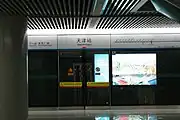| Tianjin Metro | |||
|---|---|---|---|
 | |||
| Overview | |||
| Locale | Tianjin | ||
| Transit type | Rapid transit | ||
| Number of lines | 10 | ||
| Number of stations | 217 | ||
| Daily ridership | 1.235 million (2018 Avg.)[1] 1.80 million (25 October 2019 peak)[2] | ||
| Annual ridership | 408.529 million (2018)[1] | ||
| Website | http://www.tjgdjt.com | ||
| Operation | |||
| Began operation | 28 December 1984 (original system) 12 June 2006 (new system) | ||
| Ended operation | 9 October 2001 (original system) | ||
| Operator(s) |
| ||
| Technical | |||
| System length | 301 km (187.0 mi) | ||
| Track gauge | 1,435 mm (4 ft 8+1⁄2 in) standard gauge | ||
| |||
| Tianjin Metro | |||||||
|---|---|---|---|---|---|---|---|
| Simplified Chinese | 天津地铁 | ||||||
| Traditional Chinese | 天津地鐵 | ||||||
| |||||||


The Tianjin Metro or Tianjin Rail Transit is the rapid transit system in the city of Tianjin, which was the second city in mainland China after Beijing to operate a subway system (the Beijing Subway opened in 1971). First opened in 1984, the system currently has 10 operating lines and 217 stations spanning 301 km (187.0 mi).
The lines are jointly operated by two companies: the Tianjin Metro Group Co. Ltd and the Binhai Mass Transit Development Co. Ltd. The former operates Lines 1, 2, 3, 6, and 10, while the latter operates Lines 5 and 9. The two companies merged and regrouped as the Tianjin Rail Transit Group Co. (TRT) in 2017, unifying the operations.
History
Tianjin, as an inland harbor of China, has long been a major commercial city. After the founding of the People's Republic in 1949, the number of vehicles on the roads significantly increased, causing pollution. To overcome these problems, the transport authority decided to close the old tram network and switch over to a rapid transit system.
However, due to cost, it was not until 1970 that construction of the system first took place. The first section, spanning 3.6 km (2.2 mi) of track and 4 stations (Xinhualu, Yingkoudao, Anshandao and Haiguangsi), was completed by February 1976. Further construction was delayed due to an earthquake in 1976.[3] The second section, with an additional 1.6 km (0.99 mi) of track and the Xinanjiao and Erweilu stations, was completed by 1980. After construction resumed, the total length was 7.4 km (4.6 mi), with 8 stations,[3] and service on the line began on 28 December 1984.
To reduce construction costs, the transport authority decided to use an abandoned canal bed to form part of the system, and did not dig deeply. By using the canal bed, the underground section is only 2–3 meters (6 ft 7 in – 9 ft 10 in) under the street surface, and was the world's shallowest metro. There were only 1,000 full-time construction workers at that time; the others were volunteers from factories, schools and institutions all over the city. The average number of volunteer workers exceeded 2,000 a day, which rendered the project unique in the world then. Construction was delayed in 1976 when an earthquake hit the city, but was resumed in 1979 and completed by 1984.
At the end of the 1990s, it was observed that the Metro system was quite out of date. The atmosphere of the stations was uninviting, difficult to navigate, and with few passenger amenities on the platforms. Trains were infrequent, sporadic, and commonly delayed. The trains themselves were dilapidated, seat covers often torn off, and dim. Taking into consideration more modern, cleaner systems in East Asia, a massive reconstruction, modernization and expansion plan was laid out in 2000. In preparation, the system was closed on 1 September 2001, with renovation starting on 21 November of the same year. After purchasing new rolling stock, adding half-height platform screen doors and extending the line up to Shuanglin, the line re-opened on 6 December 2006 as Line 1, after trial testing that began on 12 June of that year.
During the renovation of the first line, other lines underwent construction. Line 9, operated by Binhai Mass Transit Development Co. Ltd, began construction in 2001[3] and its first section opened on 28 March 2004. Between 2004 and 2007, many new stations on the line opened successively. On 1 May 2011, the line was further extended westwards by 3 stations, bringing it to its current length of 52.8 km (32.8 mi). The Tram line in the system, the TEDA Modern Guided Rail Tram, was built to serve the Tianjin Economic Development Area and was opened on 10 May 2007. Line 2, after a lengthy construction delay and a structural accident, finally opened, as two separate sections, to the public on 1 July 2012, with the sections being reconnected on 28 August 2013. Line 3, another main north–south line, opened in October 2012.
Lines

| Line | Terminals (District) |
Commencement | Newest Extension |
Length km |
Stations | Operator | |
|---|---|---|---|---|---|---|---|
| 1 | Donggulu (Jinnan) |
Liuyuan (Beichen) |
1984 | 2019 | 42.227 | 28 | |
| 2 | Caozhuang (Xiqing) |
Binhaiguojijichang (Dongli) |
2012 | 2014 | 27.157 | 20 | |
| 3 | Xiaodian (Beichen) |
Nanzhan (Xiqing) |
2012 | 2013 | 33.7 | 26 | |
| 4 | Dongnanjiao (Heping) |
Xinxingcun (Dongli) |
2021 | — | 19.4 | 14 | |
| 5 | Beichenkejiyuanbei (Beichen) |
Liqizhuangnan (Xiqing) |
2018 | 2021 | 34.8[4][5] | 28 | |
| 6 | Nansunzhuang (Dongli) |
Lushuidao (Jinnan) |
2016 | 2021 | 43.6 | 39 | |
| 8 | Lushuidao (Jinnan) |
Xianshuiguxi (Jinnan) |
2021 | — | 13.42 | 9 | |
| 9 | Tianjinzhan (Hebei) |
Donghailu (Binhai) |
2004 | 2012 | 52.759 | 21 | |
| 10 | Yutai (Xiqing) |
Yudongcheng (Dongli) |
2022 | — | 21.18 | 21 | |
| 11 | Dongjiangdao[6] (Hexi) |
Dongliliujinglu (Dongli) |
2023 | — | 12.27 | 11[6] | |
| Metro lines total | 301 | 217 | |||||
Line 1

Line 1 is built upon the old surface-level line, and was opened in 2006. It is 42.227 km (26.2 mi) with 32 stations (currently 27 stations in operation). The old at-grade Shuanglin station was closed on 28 December 2016 and reopened as a new underground station on 3 December 2018. The old rolling stocks (DKZ9 Series) were replaced at the same time. Line 1's color is red.
Line 2
.jpg.webp)
Line 2 opened for trial operations on 1 July 2012. Due to a structural accident in Jianguodao Station, Line 2 was operated as two separate sections from July 2012 to 28 August 2013, when the affected station opened after being rebuilt. The line is 27.157 km (16.875 mi) long with 20 stations. Line 2's color is yellow.
Line 3
.jpg.webp)
Line 3, running southeast–northwest, opened on 1 October 2012. It is 33.7 km (20.9 mi) long with 26 stations. 20 km (12 mi) of track is underground, with 1.2 km (0.75 mi) at ground level and the rest on elevated viaducts. Of the 21 stations, one is elevated, one is at ground level and the other 19 are underground. Line 3's color is light blue.
Line 4
The southern section of Line 4 will be 19.4 km (12.1 mi)[7] long. The southern section of Line 4 is opened in December 2021[8] from Dongnanjiao to Xinxingcun. Line 4's color is green.
Line 5
.jpg.webp)
Line 5 runs from Beichenkejiyuanbei to Liqizhuangnan with 28 stations. The line is 34.8 km (21.6 mi)[4][5] long with 28 stations. On 22 October 2018, the section from Danhebeidao to Zhongyiyifuyuan (26 stations) became operational. On 31 January 2019, the line was extended one station to Beichenkejiyuanbei. On 7 December 2021, the line was extended one station to Liqizhuangnan.[9] Line 5 and Line 6 forms a loop. It is run by Tianjin Binhai Mass Transit Development Co., Ltd, which becomes a subsidiary of Tianjin Rail Transit Group Corporation since 2017. Line 5's color is orange.
Line 6
Line 6 runs from Nansunzhuang to Lushuidao with a total length of 42.6 km (26.5 mi). The section from Changhonggongyuan to Nancuiping opened on 6 August 2016. The section from Nansunzhuang to Changhonggongyuan opened on 31 December 2016. The section from Nancuiping to Meilinlu opened on 26 April 2018, and the section from Meilinlu to Lushuidao opened on 28 December 2021. Line 6's color is magenta.
Line 8
Line 8, running from Lushuidao to Xianshuiguxi, opened on 28 December 2021. This line is also the first metro line in Tianjin to use Type A, GoA4 automated trains. Line 8's color is violet.
Line 9

Line 9 is an east–west line running just north of the Haihe River. It runs from Tianjin railway station to Donghai Road station. It was opened in 2004, spanning 52.8 km (32.8 mi) with 21 stations. The line provides interchange to the TEDA Tram line. Line 9 was suspended after damage from the August 2015 explosions, and resumed operation on 16 December from Tianjin Railway Station to Tianjin Pipe Corporation Station. Now, the damaged part has been reopened, along with two new stations: Zhangguizhuang and Taihulu. The line is operated by Tianjin Binhai Mass Transit Development Co., Ltd, which becomes a subsidiary of Tianjin Rail Transit Group Corporation since 2017. Line 9's color is blue.
Line 10
The Phase 1 of Line 10, from Yudongcheng to Yutai, is 21.18 km (13.16 mi) long with 21 stations. It opened in 2022.[10] Line 10's color is chartreuse.
Line 11
Line 11 will run from Shuishanggongyuanxilu to Dongliliujinglu. It is 22.6 km long with 21 stations.[11][12] Eastern part of the phase 1 of line 11, from Dongjiangdao to Dongliliujinglu (11 stations) is opened in 28 December 2023.[6]
Former service
TEDA Modern Guided Rail Tram
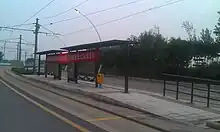
The TEDA Tram was a tram line that runs between TEDA and North of College District stations, mainly serving the Tianjin Economic Development Area (TEDA). It opened on 10 May 2007 and is 7.86 km (4.88 mi) long. It is run by Tianjin Binhai Mass Transit Development Co., Ltd, which becomes a subsidiary of Tianjin Rail Transit Group Corporation since 2017. TEDA Line's color is light green. TEDA Tram is finally closed service in 30 June 2023.
Rolling stock
There were older, box-type metro cars, built by Nippon Sharyo until the system was closed for reconstruction. After re-opening, 114 CNR Changchun Railway Vehicle Company Limited Rapid Train set Vehicle cars entered service & replaced the old ones. Unlike the old cars, the CNR cars contain air conditioning.[3]
Fares
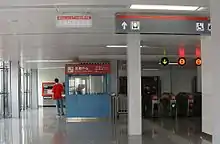
Tianjin Metro uses magnetic smartcards. The fare is distance-based and ranges between 2 and 5 yuan.
Journeys can be paid for using QR codes.[13]
One-way ticket
One-way tickets are available at automatic ticket machines, where passengers can purchase up to 9 tickets. The tickets are only effective in three hours from purchase. A ticket can be purchased from the automatic ticket machine, and recycled by simply inserting it into the turnstile when leaving the station.
Common stored value ticket
Stored-value tickets can be repeatedly used for the regular subway passengers, the fare for each journey outbound passengers through the gates when the balance deducted from the stored-value tickets. Within one year of non-use of stored-value tickets as expired, outdated stored-value tickets available at the station free update procedures for handling customer service center. Common stored value ticket holders enjoy 10% off travel.
Student discount tickets and tickets for the elderly
All full-time students attending schools, technical secondary, craftsmen, and vocational schools with student ID issued by letter may purchase student tickets and enjoy a student discount.
Seniors between 60 and 69 years old with a "Tianjin old preference card" (green) can buy discounted senior tickets, seniors 70 years old and older, with a "Tianjin old preference card" (purple) may purchase specially discounted tickets.
City Card
The City Card is a non-contact type IC card transit card similar to the Yikatong card in Beijing. It is accepted in subway, light rail, bus, ferry and taxi transport. Since 28 December 2006, City Card has been accepted on the metro line 1. City Card holders can enjoy a discounted fare during transfers between modes. This is the most popular method for long-distance traveling. Ferryboat and bus fares are not distance based.
Unlimited ride
| Period | Fare |
|---|---|
| 1 day | 18 |
| 3 days | 40 |
Future expansion
The "Tianjin Metro Phase 2 construction plan", which is approved by the NDRC, consists 513 km of lines total.[14]
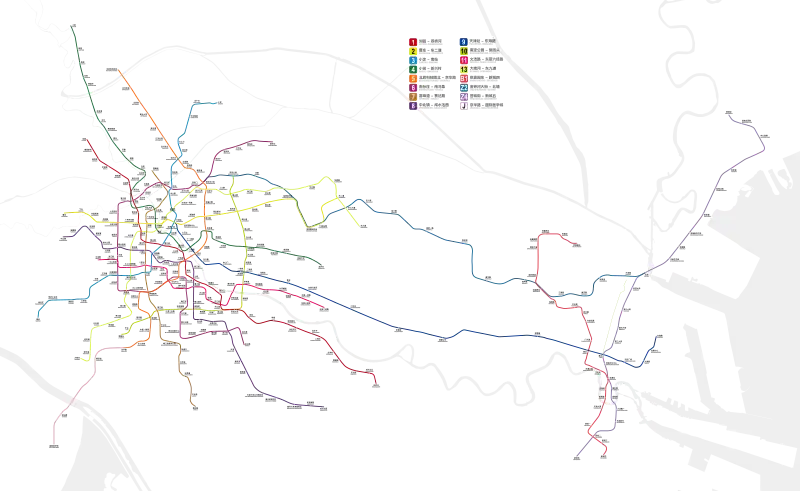
Lines under construction
| Line | Section | Terminals | Planned Opening Date | Length km |
Stations | References | |
|---|---|---|---|---|---|---|---|
| 4 | Northern section | Xiaojie | Hebeidajie | 2024 | 22 | 17 | |
| 7 | Phase 1 | Saidalu | Xifengdao | 26.53 | 21 | [11] | |
| 8 | Phase 1 (Urban section) | Lüshuigongyuan | Lushuidao | 18.54 | 17 | [15] | |
| Phase 2 | Zhongbeizhen | Lüshuigongyuan | 2025 | 4.8 | 4 | ||
| 11 | Phase 1 West | Dongjiangdao | Shuishanggongyuanxilu | 2024 | 10.33 | 10 | |
| Phase 2 | Wenjielu | Shuishanggongyuanxilu | 2025 | 3.84 | 3 | ||
| B1 | Phase 1 | Xinjiayuandong | Tianjindadao | 2024[16] | 31.28 | 21 | [17] |
| Z2 | Phase 1 | Binhaiguojijichang | Beitang | 2025 | 39.3[18] | 14 | |
| Z4 | Phase 1 | Yingchengjie | Xinchengliu | 2024[16] | 43.7 | 24 | [17] |
Line 7
Line 7 started construction in 2019 and will run from Saidalu to Xifengdao. It is 26.53 km long with 21 stations and runs north south.[11] The line will use six car Type A trains.[19]
Line B1
A 22.5 km (14.0 mi) long metro line strictly serving the urban core of Binhai connecting Binhai West railway station to the Yujiapu Financial District and Binhai railway station.[17]
Line Z2
A 39.3 km (24.4 mi) long metro line from Tianjin Binhai International Airport to Beitang station.[18] A western extension to Jinzhonghedajie station on Lines 5 and 6 is under planning.
Line Z4
A 35 km (22 mi) long suburban metro line connecting the northern suburbs of Binhai to the Tianjin Economic-Technological Development Area and Yujiapu Financial District.[17]
Gallery
Network Map
See also
References
- 1 2 2018年统计报告. China Rail Transit Association (中国城市轨道交通协会). 7 April 2019.
- ↑ 10.25全国地铁客流排行,天津再创新高 (in Simplified Chinese). 26 October 2019.
- 1 2 3 4 "Tianjin Metro - Railway Technology".
- 1 2 "开始试乘体验 天津地铁5号线开通在即". 18 October 2018.
- 1 2 "天津地铁5号线开通试运营". 22 October 2018.
- 1 2 3 "重磅 | 天津地铁11号线一期东段明天正式初期运营!". thepaper.cn (in Chinese). 27 December 2023. Retrieved 28 December 2023.
{{cite web}}: CS1 maint: url-status (link) - ↑ "最新 天津6条在建地铁进展来了!年内就有新站开通". Tianjin Radio. 25 October 2019.
- ↑ "地铁4号线8号线计划开通时间公布". 16 October 2019.
- ↑ "天津地铁5号线李七庄南站7日开通运营". 5 December 2021.
- ↑ "地铁10号线预计2022年底具备开通运营条件".
- 1 2 3 "天津地铁7、11号线全面开工". 12 July 2019.
- ↑ "天津地铁11号线一期21座站点公布". tj.people.com.cn. Retrieved 12 June 2020.
- ↑ "Beijing, Tianjin launch joint metro QR code payment system - Xinhua | English.news.cn".
- ↑ "明年地铁运营里程达300公里". 1 January 2019.
国家发改委已分两批批复我市近期轨道建设规划513公里
- ↑ "地铁4号线北辰段、8号线一期开工-新华网". www.tj.xinhuanet.com. Archived from the original on 26 January 2020. Retrieved 19 May 2020.
- 1 2 "地铁B1线和Z4线最新消息!这些项目预计2023年可建成通车……". Binhai Announcement. 21 November 2019. Retrieved 23 November 2019.
- 1 2 3 4 "天津加快地铁建设进度 这些地铁线都有新进展-新华网". www.tj.xinhuanet.com. 31 December 2018. Archived from the original on 16 January 2019. Retrieved 16 January 2019.
- 1 2 "天津地铁Z2线50%里程已开工 预计2025年通车试运营".
- ↑ "天津地铁7号线全面开工".
External links
- (in Chinese) Tianjin Rail Transit Official Site
- (in Chinese) Official site (old)
- CNR Changchun Railway Vehicle Co., Ltd Rapid Trainset Vehicle(Invailable Page)
- Urbanrail.net
- (in Chinese) Topics on Tianjin Metro
- (in Chinese) Long term plan of the metro
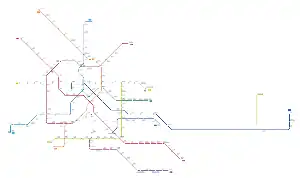
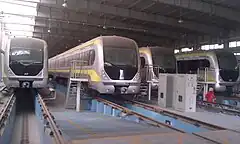
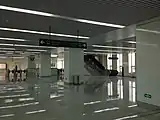
_in_Tianjin_Station.JPG.webp)
